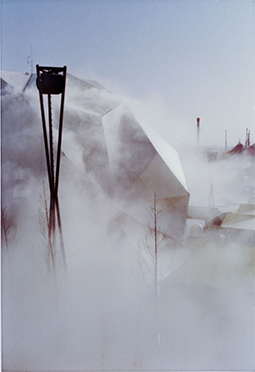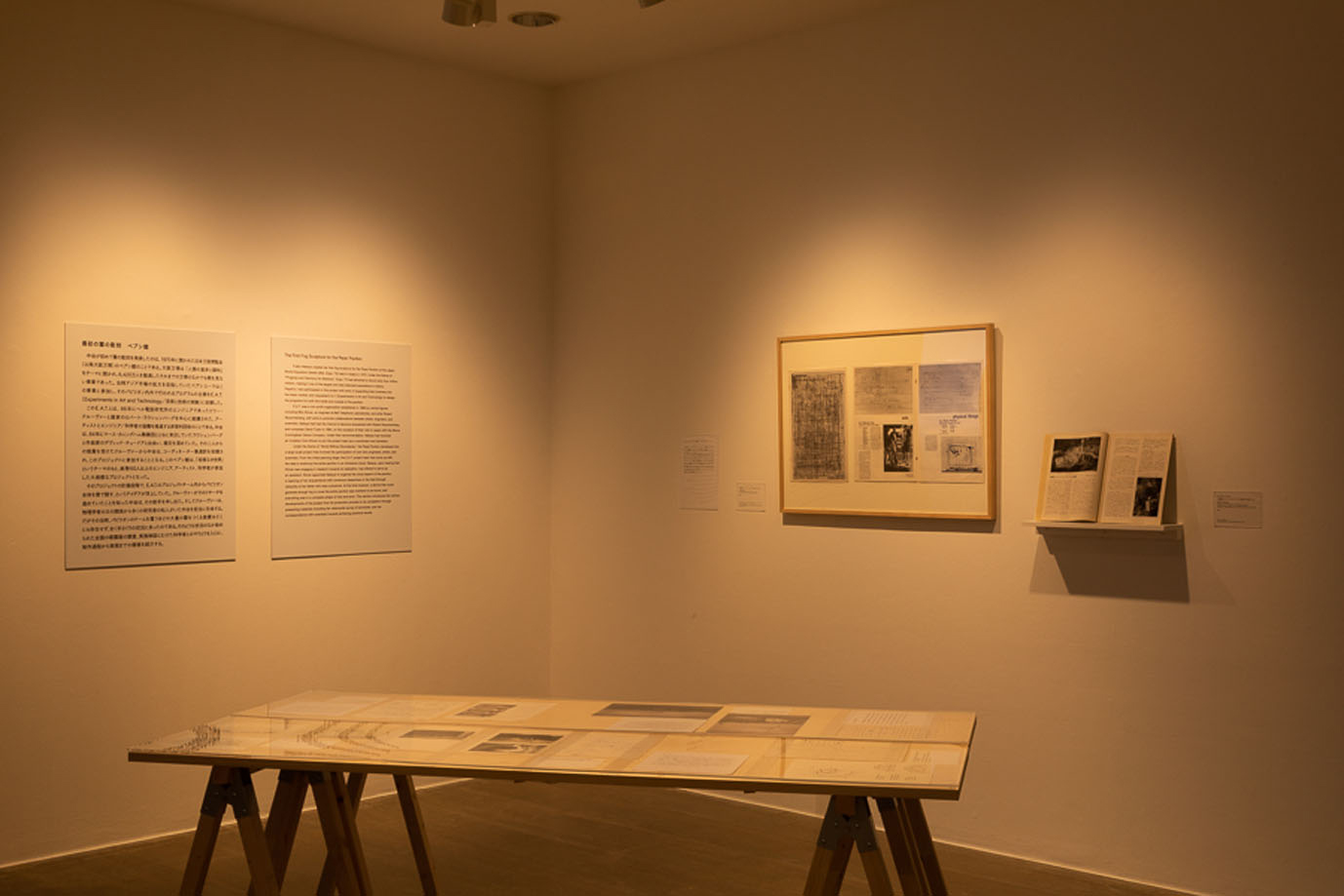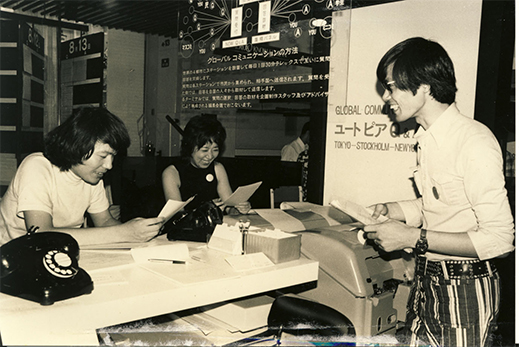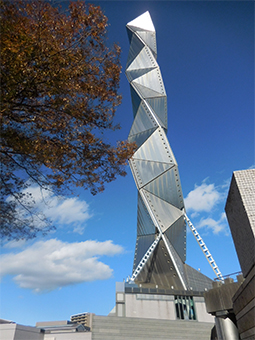 |
|
Here and There introduces art, artists, galleries and museums around Japan that non-Japanese readers and first-time visitors may find of particular interest. The writer claims no art expertise, just a subjective viewpoint acquired over many years' residence in Japan.
|
|
 |
|
|
 |
 |
The Foggiest Notions: Fujiko Nakaya at Art Tower Mito
Alan Gleason |
 |
London Fog fog performance (2017); installation view from BMW Tate Live Exhibition: Ten Days Six Nights at Tate Modern, London. Collaboration: Min Tanaka (dance), Shiro Takatani (lighting), Ryuichi Sakamoto (music). Photo by Noriko Koshida |
As a special effect, artificial fog is practically a cliché, used in everything from rock concerts to outdoor installations like the one at Tokyo Midtown this past summer. It never occurred to me to wonder how fog became such a common element of installation and performance art, but now I know: it's all thanks to Fujiko Nakaya, who created the world's first "fog sculpture" in 1970, for the Osaka Expo. Until 20 January 2019, a very misty show at Art Tower Mito's Contemporary Art Gallery tells the tale of Nakaya's remarkable life and artistic exploits.
Nakaya (born in 1933 and still going strong) had fog in her genes, you might say. Her father, Ukichiro Nakaya, was a renowned physicist who created the first artificial snowflakes using technology that later inspired his daughter in her own experiments. (For further study, visit the Nakaya Ukichiro Museum of Snow and Ice in Kaga, Ishikawa Prefecture.) Born in Sapporo, where her father spent most of his career at Hokkaido University, Fujiko attended high school in Tokyo, but chose to go to the U.S. for college, where she graduated from Northwestern University. Already a budding artist, she went on to study painting in Paris and Madrid before returning to Tokyo.
|
 |
|
|
|
Pepsi Pavilion Fog Sculpture (1970) installation view at EXPO '70, Osaka. Photo by Fujiko Nakaya
|
In the sixties she became involved in Experiments in Art and Technology (E.A.T.), an art collective founded by the visionary Bell Telephone engineer Billy Kluver and the artist Robert Rauschenberg. When E.A.T. was invited to design programs for the Pepsi Pavilion at Expo '70, they decided it would be interesting to envelop the entire pavilion in an "immersive cloud." Nakaya volunteered to handle the R&D, and the result was her, and the world's, first fog sculpture. From that point on, fog was her artistic medium of choice. As of 2017 she had produced over 80 fog sculptures around the world.
To create fog artificially, Nakaya teamed up with California-based Mee Industries, whose founder, physicist Tom Mee, had developed a special nozzle for generating fine mists for agricultural use, forming droplets 20 to 30 microns in diameter that would hang in the air and quickly evaporate like natural fog. Previous misting devices could only produce larger droplets that would fall on the plants and damage them. When Nakaya first contacted Mee, the company had only been making devices for chemical sprays like ammonia, but at her urging they developed one that worked with pure water. Thanks to that early collaboration with Nakaya, the company came to focus mainly on water fogging, and Nakaya continues to rely on Mee for her own fog-generating devices. A mutually beneficial experiment in art and technology indeed.
 |
|
Fog sculpture plans and sketches, Resistance of Fog: Fujiko Nakaya installation view in the Contemporary Art Gallery, Art Tower Mito (2018). Photo by Shintaro Yamanaka (Qsyum!); courtesy of Contemporary Art Center, Art Tower Mito |
The retrospective at Art Tower Mito covers Nakaya's career from that first Expo installation to the present (but shows none of her early paintings, alas). Exhibiting bona fide real-time fog sculptures in an indoor gallery is a daunting proposition, but the curators have done an impressive job. There are two fully functioning fog sculptures on display. Fuga occupies an entire room where fog is generated at regular intervals. Viewers stand at the rear of the dark space and watch as the mist swirls up behind a screen, then spills out toward them. From behind, aimed directly at the audience, a single bright spotlight pierces through the fog like the sun. Silhouettes of birds flying across the screen complete the euphoric sensation of floating high in the sky among clouds.
 |
|
Fuga, from the Fall series, Resistance of Fog: Fujiko Nakaya installation view in the Contemporary Art Gallery, Art Tower Mito (2018). Photo by Shintaro Yamanaka (Qsyum!); courtesy of Contemporary Art Center, Art Tower Mito |
The other sculpture is located in the outdoor plaza of the Art Tower Mito complex, where a massive red boulder hangs suspended by wires over a shallow pond. Nakaya has positioned an array of sprinklers at either end of the pond to periodically spew mist that gradually builds up, obscuring the boulder and then wafting across the plaza and enveloping passersby. As Nakaya puts it, "Fog sculptures [are] a live environment that changes constantly ... a sculpture that serves as a 'medium' that resonates with nature."
|
Resistance of Fog: Fujiko Nakaya installation views in the plaza at Art Tower Mito (2018). Photo by Shintaro Yamanaka (Qsyum!); courtesy of Contemporary Art Center, Art Tower Mito
|
One gallery features six massive video screens projecting moving images of Nakaya's installations in various locales worldwide, particularly in the U.S. and U.K. Several are in urban settings -- downtown plazas, beneath bridges -- while others fill more bucolic environments. Among them are fog sculptures at five locations in the Boston Public Garden. In a separate room, an entire wall is occupied by a monumental video of her largest work to date, Foggy Forest, which created a waterfall of mist in Showa Memorial Park on the outskirts of Tokyo in 1992. Nakaya has also collaborated on "fog performances" with dancers like Trisha Brown and Min Tanaka.
Videos of fog sculptures around the world, Resistance of Fog: Fujiko Nakaya installation view in the Contemporary Art Gallery, Art Tower Mito (2018). Photo by Shintaro Yamanaka (Qsyum!); courtesy of Contemporary Art Center, Art Tower Mito |
If fog weren't enough to put her on the map, Nakaya is also a pioneer in video art. Her first such work,
Friends of Minamata Victims -- Video Diary (1972), documented protests against the company whose mercury pollution caused Minamata Disease. In 1980 she opened Video Gallery SCAN, Japan's first space devoted to video art. As typified by her Minamata work, Nakaya has always demonstrated a concern with environmental issues -- pollution not only of the natural environment, but also of what she calls
the "media ecology." But she can also be whimsical, as in her video Statics of an Egg, which records participants' fruitless attempts to stand an egg on end. The Mito show devotes generous space to this side of Nakaya's oeuvre, including a table with a bowl of eggs (raw, the sign warns) with which visitors can try their own egg-balancing luck and watch themselves on live video
in the process.
 |
|
Utopia Q&A 1981 (1971), showing E.A.T. Tokyo members at the project's Tokyo telex terminal. From left: Hakudo Kobayashi, Fujiko Nakaya, and Yuji Morioka. Photo by Shoji Fukazawa |
In 1971 Nakaya worked with E.A.T. on another pioneering project, one of the first attempts to create an interactive work among participants in far-flung cities: Stockholm, New York, Ahmedabad, and Tokyo. In those pre-Internet days their medium of choice was the telex. An entire gallery is devoted to this work, Utopia Q&A 1981, in which provocative questions addressed to such recipients as artists, scientists and philosophers asked how they expected the world to be a decade later. Excerpts from those 400 questions and answers, plastered the length of the wall in telex printouts, are fascinating and often disturbingly prescient.
Utopia Q&A 1981 chart and telexes, Resistance of Fog: Fujiko Nakaya installation view in the Contemporary Art Gallery, Art Tower Mito (2018). Photo by Shintaro Yamanaka (Qsyum!); courtesy of Contemporary Art Center, Art Tower Mito |
The common thread in Nakaya's work, whatever the medium, is her concern about the destructive turn taken in people's relations with one another and with nature at large. On one level her fog sculptures are highly conceptual, intended to "connect human beings with nature" and serve as an allegory of resistance (as the exhibition title suggests) to forces that wreak havoc upon the world and the human heart. But they are also beautiful and moving on their own terms, enshrouding their surroundings in an atmosphere of peace and mystery and thus quietly transforming them. In a video about the Pepsi Pavilion that she narrates in English, Nakaya says, "Fog is always changing ... We can play and hide in it. It's a negative sculpture covering the positive sculpture of reality."
|
 |
|
|
|
The 100-meter tower at Art Tower Mito is a city landmark. An elevator ride to the top affords panoramic views of Mito and environs. Photo by Alan Gleason
|
The Contemporary Art Gallery is part of a large cultural complex that includes a theater, concert hall, and the 100-meter-high spiraling metal tower that is Art Tower Mito's symbol. Built in 1990, the tower itself is a dramatic work of monumental sculpture that contrasts with the rest of Mito, a sedate old castle town that is the capital of Ibaraki Prefecture. An easy day trip from Tokyo, the city also boasts another recommended destination -- Kairakuen, one of Japan's "three great gardens."
All images shown by permission of the Contemporary Art Center, Art Tower Mito. |
 |
| Resistance of Fog: Fujiko Nakaya |
| 27 October 2018 - 20 January 2019 |
| Contemporary Art Center, Art Tower Mito |
1-6-8 Goken-cho, Mito, Ibaraki Prefecture
Phone: 029-227-8111
Open 9:30 a.m. to 6 p.m. (last admission at 5:30 p.m.)
Closed Mondays (except 24 December, 14 January, and public holidays), 25 December, 27 December to 3 January, and 15 January
Access: Art Tower Mito is a 20-minute walk from JR Mito Station, so taxi or bus is recommended. From the north exit of the station take any bus for Daiku-machi and get off at Izumi-cho 1-chome, the fourth stop. The museum is a 2-minute walk. Mito is a bit over an hour from Tokyo by limited express on the JR Joban Line. |
|
|
|
| |
 |
Alan Gleason
Alan Gleason is a translator, editor and writer based in Tokyo, where he has lived for over 30 years. In addition to writing about the Japanese art scene he has edited and translated works on Japanese theater (from kabuki to the avant-garde) and music (both traditional and contemporary). |
|
|
|
|
|
|
|
|
|
 |
|